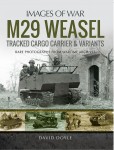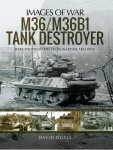Friday, February 08, 2019 - 12:48 PM UTC
David Doyle Books adds two new titles to its Images of War Series focusing on the Studebaker Weasel and the Jackson tank destroyer.
New books by David Doyle:
M29 Weasel - Images Of War
The Studebaker Weasel family of vehicles is explored. The Top Secret T15, followed by the T24, M29 and amphibious M29C are all explored through a mixture of wartime photos and highly detailed images of some of the finest existent preserved examples. Softbound edition, with 259 photos over 168 pages
The book is scheduled to be released in April / May 2019, and is currently open for pre-order. Those who reserve copies in advance through DavidDoyleBooks.com will receive author-signed copies, AND free shipping to US addresses.
M36 / M36B1 Tank Destroyer - Images Of War
Going into WWII, the prevailing strategy of the US command was that tanks were not to be used to engage enemy tanks in combat. Rather, tanks were to be the armored spearhead to breach enemy positions. Enemy tanks were to be dealt with by specialized weapons, aptly named tank destroyers.
While the 3-inch weapon of the M10 was superior to that found on earlier US tank destroyers, it was still found to be inadequate against the ever-increasing weight of German armor. An even larger gun, the 90mm M3, was placed in a new, bigger open-topped turret on 100 new hulls purpose built for this, and by remanufacturing M10A1s, primarily from US-based training units. As the supply of these chassis was depleted, additional vehicles were created by converting Diesel-powered M10s, resulting in the M36B2. The M36B1 was built from the ground-up as a tank destroyer, using a hull based on that of the M4A3 but featuring a standard M36 turret. Examination of rare surviving vehicles indicates that the M36B1 hulls were manufactured expressly for this purpose, and were not merely M4A3 hulls that were converted.
While US antitank doctrine changed, rendering all the tank destroyers obsolete post-WWII, many of these vehicles were supplied to other nations, and in fact some survived as combat vehicles into the 21st century.
Scheduled for release in April 2019, the book will be available as a softbound edition containing 122 pages. Currently open for pre-order with free shipping to US addresses.
M29 Weasel - Images Of War
The Studebaker Weasel family of vehicles is explored. The Top Secret T15, followed by the T24, M29 and amphibious M29C are all explored through a mixture of wartime photos and highly detailed images of some of the finest existent preserved examples. Softbound edition, with 259 photos over 168 pages
The book is scheduled to be released in April / May 2019, and is currently open for pre-order. Those who reserve copies in advance through DavidDoyleBooks.com will receive author-signed copies, AND free shipping to US addresses.
M36 / M36B1 Tank Destroyer - Images Of War
Going into WWII, the prevailing strategy of the US command was that tanks were not to be used to engage enemy tanks in combat. Rather, tanks were to be the armored spearhead to breach enemy positions. Enemy tanks were to be dealt with by specialized weapons, aptly named tank destroyers.
While the 3-inch weapon of the M10 was superior to that found on earlier US tank destroyers, it was still found to be inadequate against the ever-increasing weight of German armor. An even larger gun, the 90mm M3, was placed in a new, bigger open-topped turret on 100 new hulls purpose built for this, and by remanufacturing M10A1s, primarily from US-based training units. As the supply of these chassis was depleted, additional vehicles were created by converting Diesel-powered M10s, resulting in the M36B2. The M36B1 was built from the ground-up as a tank destroyer, using a hull based on that of the M4A3 but featuring a standard M36 turret. Examination of rare surviving vehicles indicates that the M36B1 hulls were manufactured expressly for this purpose, and were not merely M4A3 hulls that were converted.
While US antitank doctrine changed, rendering all the tank destroyers obsolete post-WWII, many of these vehicles were supplied to other nations, and in fact some survived as combat vehicles into the 21st century.
Scheduled for release in April 2019, the book will be available as a softbound edition containing 122 pages. Currently open for pre-order with free shipping to US addresses.
Click Star to Rate
5 readers have rated this story.
THIS STORY HAS BEEN READ 4,389 TIMES.










Comments